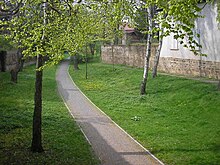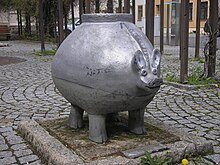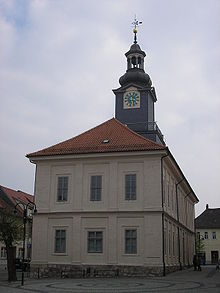Greetings
| coat of arms | Germany map | |
|---|---|---|

|
Coordinates: 51 ° 14 ' N , 10 ° 57' E |
|
| Basic data | ||
| State : | Thuringia | |
| County : | Kyffhäuserkreis | |
| Management Community : | Greetings | |
| Height : | 162 m above sea level NHN | |
| Area : | 19.21 km 2 | |
| Residents: | 3432 (Dec. 31, 2019) | |
| Population density : | 179 inhabitants per km 2 | |
| Postal code : | 99718 | |
| Area code : | 03636 | |
| License plate : | KYF, ART, SDH | |
| Community key : | 16 0 65 023 | |
City administration address : |
Markt 1 99718 Greußen |
|
| Website : | ||
| Mayor : | René Hartnauer ( SPD ) | |
| Location of the city of Greußen in the Kyffhäuserkreis | ||
Greußen is a country town in the Kyffhäuserkreis in Thuringia . Greußen is the largest city in the administrative community Greußen and its seat.
Greußen consists of the city of Greußen and the district of Grüningen .
location
The city of Greussen is located at the foot of the southern slope of the Hainleite in the Thuringian Basin in an arable area. The city and its district is traversed by the Schwarzburger, the Loch-, the Kupfer- and the Saxon Helbe as well as the Steingraben, the original bed of the Helbe . The federal road 4 and the state roads 2133 and 1041 open up the city with traffic. The Erfurt - Nordhausen railway line runs through the city with a station in Greußen.
history
Before 1871
In prehistoric and early historical times, the Greussental was covered by a lake that was flooded by erosion around the time of Christ's birth. The Greussen tuff is geologically interesting . Numerous archaeological finds testify to a strong settlement of the area around the lake in prehistoric times. One of the most valuable finds in northern Thuringia was made in a wooden shaft north of Greußen in 1858. The sacrificial find consists of six Germanic cult vessels from around 200 AD. One of them, the Greussian piglet , has the shape of a boar.
In 860 the place was mentioned as Gruzzi . The place name comes from the Old High German word Grus for sand. From this in turn Gruzen - "a place on sand" is derived. In the Carolingian era , the area of the "Drei Greußen" (West, Cling and Markt Greußen) came to the Fulda Monastery as a gift from Franconian landlords . The area of the old town was settled around 900. The area was under the rule of the Ludowingers , then the Wettins , from 1319 the Counts of Honstein and from 1356 the Counts of Schwarzburg .
In the district of Grüningen there was a castle on the site of the castle. The hill of these buildings was and is flowed around by the watercourse of the Helbe . In the 13th century, lords of Grüningen were named in documents who were certainly owners of the castle. A retirement home and kindergarten were founded on the medieval site, which only consisted of ramparts, ditches and remains of walls.
In 1250, the Wettin landgrave founded the town of Marktgruzen . In 1353 Greußen received city rights. It was also allowed to mint its own coins, the Greussian pfennigs . The place benefited from its location at the crossroads of trade routes, was a "local market" for a wider area and became a craft settlement. Especially in the 16th century were wine and Waid -Anbau important. The mining of Greussen tuff and the Helbe below also played an important role economically . In 1491 Greußen burned down to twelve houses. In the Thirty Years' War there was “looted, robbed and beaten to death by all parties”. In 1625, 843 of 1,300 inhabitants died of the plague . In 1687 Greußen was hit by a severe fire in the city. In the Napoleonic Wars from 1807 to 1813, the Principality of Schwarzburg-Sondershausen had to provide soldiers for the Napoleonic troops. In 1810 a Greussian unit in Spain was wiped out. In 1834 a major fire destroyed almost the entire city. The upper parts of the formerly much higher city wall were also used for the reconstruction.
1871 until now
In the second half of the 19th century Greußen also took part in the rapid industrialization , especially after the establishment of the German Empire in 1871. In 1878, the city's “Beautification Association” was launched.
Until 1918 Greussen belonged to the subordinate rule of the Principality of Schwarzburg-Sondershausen , then from 1920 to the State of Thuringia , from 1952 to 1990 to the district of Erfurt , since then to the federal state / Free State of Thuringia.
During the Second World War , prisoners of war from the Soviet Union and women and men from Poland had to do forced labor in agriculture . Eleven Polish women were killed in an Allied bombing raid in April 1945 because they could not take shelter in the field in which they were working. Together with 19 German bomb victims they were buried in the local cemetery. Four perished Soviet forced laborers lie in the cemetery in the Grüningen district.
On April 7, 1945, shortly before the end of World War II , Greußen experienced two attacks by American fighter-bombers . A number of residential buildings fell victim to this, and the town hall was also damaged. There were 36 civilian deaths, including 13 children. On April 11, 1945 Greussen was occupied by the US Army without a fight . This was replaced by the Red Army at the beginning of July - in accordance with the London Agreement of September 1944 on the formation of zones of occupation in Germany - and the area became part of the Soviet Zone . The savings bank building became the Soviet headquarters, a commercial building (today a branch of the Rossmann drugstore chain ), the seat of the NKVD . All leading administrative offices and the police were occupied by communists. Denazification, arrests, deportations, expropriations and confiscations followed. The place went along with all political and economic changes in the Soviet Zone and from 1949 in the GDR .
From October 1945 to January 1946 38 Greußener youths were due to denunciations under werewolf arrested -Vorwurf, delivered to the NKVD, by a Soviet military tribunal sentenced in Sondershausen to long prison sentences and-without informing the parents in the infamous Special Camp No.. 7 Sachsenhausen admitted . Of the 38 innocent “ Greussen boys ” who were convicted , 24 died there under extreme conditions. The 14 survivors were only released in 1950. The decision to erect a memorial to these events was taken by the first city councilor of Greußen , who was freely elected again after the political change , at its first meeting. On November 24, 1990, the memorial stone was inaugurated in the presence of four survivors.
Population development
Development of the population (December 31) :
|
|
|
|
|
- Data source: Thuringian State Office for Statistics
politics
The city of Greußen is a member and seat of the administrative community Greußen.
City council and mayor
The local elections on May 26, 2019 led to the following result for the composition of the local council:
| Political party: | SPD | CDU | NPD | total |
|---|---|---|---|---|
| Seats: | 9 seats | 6 seats | 1 seat | 16 seats |
| Share of votes: | 57.8% | 36.8% | 5.3% | 100% |
In addition, the separately elected mayor belongs to the municipal council. This is in Greußen René Hartnauer.
coat of arms
Blazon : "Sharing accompanied In Blue, a blue armored and helmeted riders in natural colors on goldgezäumtem, goldbehuftem, silver Ross, with silver sword his red cape down from a blue tag, in a crowned golden lion."
The oldest seal from 1369 shows St. Martin on horseback and a small shield with the Blackburg lion . Saint Martin is the patron saint of the church in Greußen.
Town twinning
Greußen maintains a partnership with
-
 Creußen in Bavaria ( Upper Franconia ).
Creußen in Bavaria ( Upper Franconia ).
Attractions
- The Protestant Church of St. Martini was built in its current form mainly after the great city fire of 1687, with remnants of the previous building being used. The renovation, which has been going on for several years, has so far (as of 2008) been three-quarters complete.
- The free-standing town hall burned down completely in 1491 and 1687. In 1834 the surrounding walls remained standing after the fire and formed the basis for the reconstruction. Comprehensive restoration was carried out by 2006. She was honored with the Thuringian Monument Prize. Next to the town hall is the "Greußen Piglet": the enlarged replica of a Germanic cult figure found near Greußen from the period between 200 and 300 AD.
- The local history museum has been in the town hall since September 2008: modernized and supplemented on the basis of the extensive collection by Paul Lührmann.
- The market square is elongated on one side of the town hall and the pottery market on the other side of the town hall.
- A memorial from 1990 in the grounds in front of the state regular school (former community school) commemorates: To commemorate the first victims of Stalinism in Greußen 1945/1946 ", with the names of the 38" Greussener boys "concerned . 24 of them came to the Sachsenhausen special camp around.
- A memorial for those who died in World War I was erected in 1922. After 1945 the warrior's body was removed, but recovered and put back on the base after the fall of the Wall . Some of the names are weathered (2014). The base of the monument bears an additional plaque with the inscription: "In honor of those who fell in World War II and all victims of tyranny, expulsion and flight. The citizens of Greussen"
- The house of the Pressler Foundation is a deaconess home.
- The Kulturhaus was the town's club and meeting center as a rifle house until 1945 , then temporarily the seat of the SED and Antifa local groups. Today there is a restaurant there
- The city wall is partially preserved twice with the Zwingermauer, albeit considerably lower than before. The moat has been filled in, followed by a green belt and partly lined with small gardens. A plaque on the wall commemorates the Justice Captain Hartmann from the city's beautification association.
- The old malt factory is a big industrial ruin .
- In Grüningen Castle in the district of Grüningen, the important German early romantic Friedrich von Hardenberg (Novalis) met his future fiancée Sophie von Kühn in 1794 , who died a little later.
- The village church of St. Peter in Grüningen shows a remarkable, embedded in the church wall grave plate of the nobleman Caspar of Kutzleben (from the castle Grüningen) and a medallion with a small image and text: In this cemetery rests Sophie von Kühn , born March 17, 1782, d. March 19, 1797 at Grüningen Castle. The bride of the poet Friedrich von Hardenberg <Novalis> . Notable tombs can be found in the churchyard. The last owners of the Grüningen castle and manor, the Nette couple, also rest here. It was expropriated and expelled in 1945.
- The Helbe system is a listed building. It is formed by the river Helbe in the middle and two artificial river arms (Schwarzburger Helbe in the north and Saxon Helbe in the south). The complex dates back to the 13th century.
- The Funkenburg near Westgreußen is an exposed and partially reconstructed fortified Germanic settlement from the time from 300 to 100 BC. Chr.
Economy and Infrastructure
The place lives mainly from agriculture and agricultural processing products. The Greußener Salami, which has been produced for decades, is known nationwide. Greußener Salami is a protected geographical indication . There are also a large number of small and medium-sized businesses.
traffic
- Railway station on the Wolkramshausen – Erfurt railway line ,
- The federal road 4 leads through the place.
education
In Greußen there has been a state high school " Friedrich von Hardenberg " (before that POS " Hans Beimler "), a state regular school (before that POS " Juri Gagarin ") in the secondary and secondary schools and a primary school (before that EOS later POS " Karl Marx ").
Sports
- Football field from 1925
- Municipal swimming pool from 1933
- Tennis court from 1934
societies
- Heimatverein Marktgruzen e. V.
- Association for the preservation and promotion of the St.Martini-Kirche zu Greußen e. V.
- SV Blau-Weiß Greußen e. V.
- MTV 1861 Greußen e. V. (Männer-Turn-Verein), uses the 4 F of the German gymnastics movement (Frisch-Fromm-Fröhlich-Frei) as its symbol, from 1949 to 1990 BSG tractor
- Schützengesellschaft Greußen e. V.
- Greußen Carnival Club Weiss-Blau e. V.
Sons and daughters
- Wilhelm Ernst Tentzel (* 1659 in Greußen, † 1707 in Dresden), scholar, historiographer and numismatist
- Johann Gottfried Krause (born June 29, 1685 in Greußen; † September 25, 1746), German theologian and hymn poet
- Johann Christoph Klemm (1733–1795), sculptor, worked a. a. in Ebeleben Castle
- Ernst Christoph Dressler (born September 23, 1734 in Greußen; † April 6, 1779 in Kassel), German composer, tenor, violinist and music theorist
- Immanuel Gottlieb Huschke (born January 8, 1761 in Greußen; † February 18, 1828 there), German classical philologist who worked as a professor at the University of Rostock .
- Eduard Klemm (1838–1926), member of the Reichstag and Landtag
- Hermann Pressler (1844–1911), businessman in Greußen, founder of the Pressler Foundation . The "Pressler-Stift" house served as a diaconal center for 60 years
- Carl Boerner (1846–1929), member of the Reichstag and Landtag
- Hermann Hesse (1867–1930), Dr. phil., court pharmacist and author of the book Heimatbuch der Stadt Greußen / Thür. 1927
- Paul Lührmann (1879–1968), pharmacist, local researcher with many publications, author of the book From Greussen's Past 1957. His collections form the basis of the Greußen local history museum.
- Ernst Zitzmann (* 1891), politician (NSDAP)
literature
- Hermann Hesse: Home book of the city Greußen / Thür. , 1927.
- Paul Lührmann: From Greussen's past , 1957.
- Greuss in Handbook of the Historic Sites in Germany - Thuringia . Edited by H. Patze and PA ufgebauer, Kröner-Verlag Stuttgart 1989. ISBN 3-520-31302-2 .
- Juliane Geick: Six Christmas ( no film about the festival of love ), film, shown in 1993/94 by mdr and ORB (eyewitness reports: Greußener Jungs).
- Günter Agde: The Greussen boys . Dietz-Verlag Berlin, 1995. edition reiher.
- Greußen then and now : Paul Lührmann (1961) with additions by Waldemar Kämmer, ed. Heimatverein Marktgruzen e. V., 1997.
- Otto Zimmermann: Greußen / Thuringia. A reflection from old and new times . Published by City of Greußen, Starke-Druck, Sondershausen 2003. ISBN 3-9808465-3-9 .
Web links
Individual evidence
- ^ Population of the municipalities from the Thuringian State Office for Statistics ( help on this ).
- ↑ Michael Köhler: Thuringian castles and fortified prehistoric and early historical living spaces. Jenzig-Verlag, 2001, ISBN 3-910141-43-9 , p. 120
- ↑ Thuringian Association of the Persecuted of the Nazi Regime - Association of Antifascists and Study Group of German Resistance 1933–1945 (ed.): Heimatgeschichtlicher Wegweiser to places of resistance and persecution 1933–1945, series: Heimatgeschichtliche Wegweiser Volume 8 Thüringen, Erfurt 2003, p. 169 , ISBN 3-88864-343-0
- ↑ Jürgen Möller: The fight for northern Thuringia in April 1945 . Verlag Rockstuhl, Bad Langensalza 2010. P. 132. ISBN 978-3-86777-212-9
- ↑ Thuringian State Office for Statistics, municipal council election 2019 in Thuringia - final result for Greußen , accessed on October 24, 2019
- ^ New Thuringian Wappenbuch Volume 2, page 25; Publisher: Arbeitsgemeinschaft Thüringen e. V. 1998 ISBN 3-9804487-2-X
- ^ Renovation of Greußen town hall on the website of the Thuringian Chamber of Architects
- ↑ European Commission: Agriculture and Rural Development








